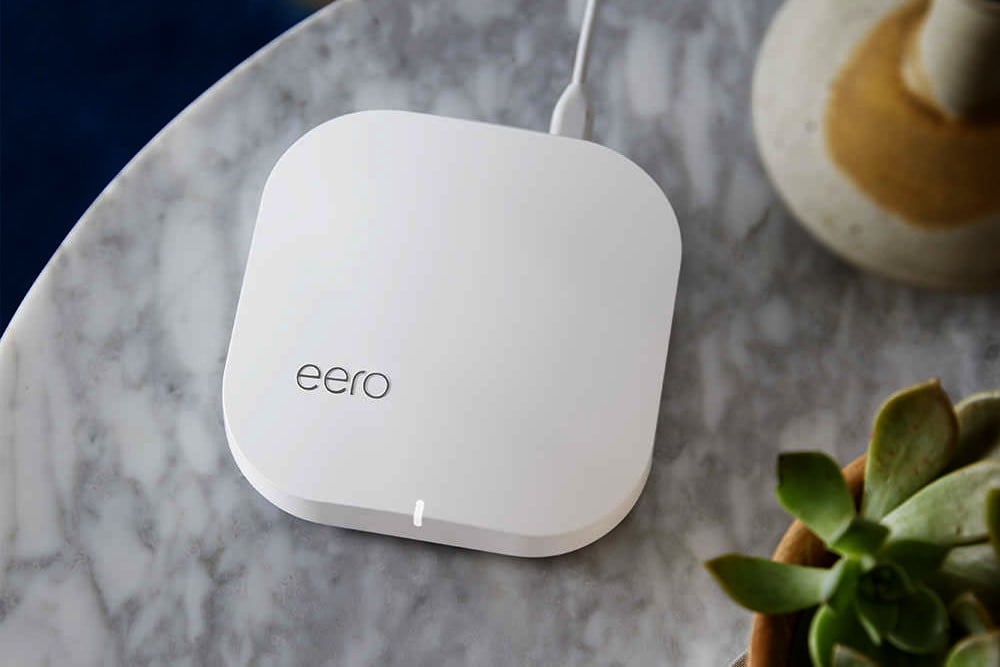If you need to improve or extend your Wi-Fi coverage, you have two options. The first is an extender, and the second is a mesh router. An extender, otherwise known as a repeater, retransmits your Wi-Fi’s data stream. A mesh router acts as a Wi-Fi hub in whichever room it is located.
Both options will improve a weak connection over a broad area, but mesh routers are better for a full replacement, and they’re generally easier to set up. Here’s a list of the best on the market today, starting with Nest‘s excellent app-managed mesh routers.
Best mesh Wi-Fi systems
Nest Wi-Fi
Why you should buy this: Google Nest delivers great Wi-Fi coverage in a well-designed package that fits into most homes.
Who’s it for: Home users who don’t want to mess with complex Wi-Fi settings and value ease of use.
Why we picked the Google Nest mesh system:
The Nest Wi-Fi system is a mesh Wi-Fi solution that offers aC2200 speeds designed for large spaces — two models can cover as much as 4,400 feet when linked together, and you can make the system larger or smaller depending on how many units you buy. We liked Google’s first attempt at mesh Wi-Fi for its ease of use, but Nest Wi-Fi makes it even easier to set up and manage the router, especially if you have any experience with the Google Home app.
They’re also smart. Specifically, they have speakers and include Google Assistant, so you can give them voice commands and use them throughout the day (as opposed to most routers, which just sit there). The speakers aren’t quite big enough for impressive music, but they’re great for changing your schedule or getting updates and answers to your questions. If you have other Nest or Google Assistant devices around the home, then you also can control them via these routers. You can read more details in our full review.
Note that you have options to buy anywhere from one to three units of Nest WiFi depending on the space that you want to cover.
Netgear Nighthawk MK62
Why you should buy this: Netgear’s Nighthawk delivers fast speeds and can blanket a large area with great signal.
Who’s it for: Gamers and streamers who value speed.
Why we picked the Netgear Nighthawk MK62:
The Nighthawk line also has a highly capable mesh router, and if you’ve used a Nighthawk router before then you know the app is highly capable when it comes to monitoring your system, making settings changes, and enabling more security. The AX1800 router supports coverage up to 3,000 square feet with its included satellite and can handle more than 25 devices.
The dual-band router can offer speeds up to 1.8Gbps across four Wi-Fi streams, plus two Gigabit Ethernet ports (one per device) for wired connections that may require higher speeds or more reliability.
The Netgear Nighthawk MK62 router is also Wi-Fi 6 ready, so if you have compatible Wi-Fi 6 devices you can enjoy the big boost in bandwidth. Even if you don’t, the router still supports beamforming and MU-MIMO for older devices.
Vilo Mesh Wi-Fi system
Why you should buy this: Vilo makes getting started with a mesh network simple and affordable.
Who’s it for: Home users on a budget who want to get started with a mesh network.
Why we picked Vilo’s mesh Wi-Fi network:
Vilo‘s mesh network may not sound as impressive as some of its more modern contemporaries on this list — the system tops out at Wi-Fi 5 support and it doesn’t support WPA3 security protocols — but at $20 for a single node or $60 for a complete multipack mesh system that can blanket a home as large as 4,500 square feet, it’s the most affordable pick. At that price, it makes Vilo’s mesh network a great option for those dipping their toes into the mesh ecosystem, and given that most electronics that you own aren’t Wi-Fi 6 ready yet save for the newest smartphones and laptops, being constrained to Wi-Fi 5 may not be so bad if it means saving a few hundred dollars.
Like its more expensive competitors, Vilo’s system benefits from an easy-to-use app that you will use to set up the network, establish parental controls, and create a guest network. Vilo’s app appears to be more advanced than some others on the list — the guest network, for example, can expire after a set number of hours. Firmware updates are downloaded in the background to ensure that everything runs smoothly, and the router’s compact size keeps it out of view if you don’t want unsightly tech in your living space.
Eero Home Wi-Fi System
Why you should buy this: Eero 6 brings Wi-Fi 6 speeds and features in a minimalist design.
Who’s it for: Home users needing Wi-Fi 6 coverage and who have broadband speeds of 500Mbps or less.
Why we picked the Amazon Eero 6 mesh network:
Like the company’s previous Eero mesh router system, the new Eero 6 mesh router adds support for the newer, faster dual-band Wi-Fi 6 standard. Available in retail packs with a single hub, a hub and two beacons, or even three hubs, the Eero 6 can blanket large homes up to 5,000 square feet in size, and you can add even more beacons to expand your coverage for outdoor spaces. The company claims that its Eero 6 mesh system is great for internet connection speeds up to 500 Mbps. If you have a fiber broadband plan with gigabit speeds, you’ll want the faster Eero Pro 6, which benefits from a tri-band antenna and comes with a smartphone hub built-in so you can connect your Zigbee devices without needing a separate base station.
The company also offers its own parental controls through a subscription service called Eero Secure. If you opt into the package, you gain access to tools like VPN, access to 1Password password manager, Malwarebytes anti-malware tools, and more insight and control over your home network. The router stays updated with automatic firmware updates in the background, and you’ll benefit from Eero’s simple ease of use.
TP-Link Deco
Why you should buy this: TP-Link’s Deco allows up to 100 devices to be connected at any time.
Who’s it for: Home users looking to host a network of IoT devices.
Why we picked the TP-Link Deco:
The set of three TP-Link Deco devices can extend a wireless network up to 4,500 square feet and can connect more than 100 devices at once, which may be a nice feature for a public or business environment. The control options offer plenty of customization options too, including device prioritization, filtering internet content, and Wi-Fi pausing for the kids. When left to its own devices, the Deco uses adaptive routing to choose what looks like the fastest connection for devices on a first-come, first-served basis. You also get three free years of Trend Micro antivirus security. All in all, it’s one of the best packages for businesses that want to provide reliable Wi-Fi to their customers.
Ubiquiti Amplifi HD Wi-Fi System
Why you should buy this: Ubiquiti Amplifi makes it easy to see your network stats with a convenient LCD display on the base.
Who’s it for: More tech-savvy users needing more control of their home network and speeds.
Why we picked the Ubiquiti Amplifi HD Wi-Fi System:
The Ubiquiti Amplifi HD Wi-Fi System comes with a main router hub that features a very nifty round screen that can display your current router speeds and other useful information at a glance. Then it uses two antenna-shaped “mesh points” for extending the network even farther — up to an impressive 10,000 square feet for extra-large spaces. The mesh points use a very handy set of LEDs to show signal strength so you can choose the best spots to place them. If you’re a big fan of on-device information, this system has your back — but there’s also an easy app to use for setup and management.
Netgear Orbi
Why you should buy this: Orbi brings Wi-Fi 6 support with a tri-band antenna to deliver faster speeds.
Who’s it for: Gamers and 4K streamers who need fast Wi-Fi speeds and wide coverage.
Why we picked the Netgear Orbi Wi-Fi system:
Based on the company’s previous design for its mesh network routers, Orbi’s new Mesh WiFi 6 System gets an updated design that supports Wi-Fi 6 network connectivity with a tri-band antenna. The updated Wi-Fi 6-enabled models allow you to connect more devices, get faster speeds, and offer more coverage. Netgear, Orbi’s maker, claims that you can blanket a space of 12,500 square feet with its mesh system. Orbi’s system comes in various sizes, ranging from a two-pack with a satellite receiver to a five-pack model for maximum coverage and expandability. The system allows you to “stream multiple 8K/4K videos at up to 6Gbps, all at the same time,” Netgear said.
Setup and control are done through a convenient smartphone app, and like some of its competitors, Netgear also sells optional subscription services that may benefit some home users, including Netgear Armor for cybersecurity protection and an extended warranty ProSupport for Home option.
Asus ZenWiFi XT8
Why you should buy this: Asus’s Zen WiFi pairs with the company’s existing routers, making it easy to expand from a single router to a whole home mesh network.
Who’s it for: Gamers, home users, and 4K video streamers.
Why we picked the Asus Zen WiFi XT8:
Asus supports AiMesh software to make its ZenWiFi routers easy to operate and compatible with any additional routers that also have AiMesh, which means an older router may be able to help serve as a satellite device without extensive work, expanding coverage even farther beyond the 5,500 square foot coverage the powerful router pack already offers. The router also comes with free parental controls and security software for extra management options.
The router system is Wi-Fi 6 and ready to provide all the latest features for compatible devices, including MU-MIMO direct connections, OFDMA data compression, and other improvements from faster Wi-Fi generations. Its three bands can provide a combined speed of 6600Mbps.
The Asus ZenWiFi XT8 is another pricey model compared to a traditional router, but an excellent choice if you want a particularly powerful system that is ready with Wi-Fi 6 features.
Mesh Wi-Fi system buying guide and FAQs:
Why a mesh system over a traditional router?
While standard routers are often more affordable than mesh Wi-Fi systems, going with the latter allows you to have a much more reliable connection. Multiple nodes help to blanket your entire home with a good Wi-Fi signal, and mesh systems improve coverage and reliability. Additionally, many mesh Wi-Fi systems allow for a simple setup with intuitive, easy-to-use apps rather than an intimidating web-based user interface that’s used by traditional routers. Many mesh networks come with support for MU-MIMO — or multiple user, multiple input, multiple output — support, which helps to keep data speeds fast when multiple devices are connected simultaneously to the network. This can help in households where you’re streaming multiple video feeds and gaming. Even in smaller homes, you can opt to use a mesh system rather than a traditional router. Here, we recommend you use a single node instead of buying a multipack bundle with three nodes.
Do I need a smartphone to set up a mesh Wi-Fi network?
Oftentimes, the answer is yes. You’ll need to have a modern smartphone or tablet running Apple’s iOS or iPadOS or Google’s Android OS. The requirements for which operating system version will be required will vary based on the mesh system you choose. Mesh systems require you to install a mobile app, create a login with a username and password, and then access the app to both set up the network and access your home Wi-Fi network’s controls.
What controls are available through my mesh network app?
This will vary based on the device and manufacturer you choose. The mesh network app will give you basic and advanced controls, like the ability to either restart your network on-demand or create a schedule so that your network automatically restarts every week or every night. Many of the mesh systems allow you to either choose the band that’s best for your device — either 2.4GHz or 5GHz — or give you the ability to manage band steering yourself manually. Wireless security, device usage reports, and parental controls are also features that you can set up. Parents can set up downtime, allowing them to restrict internet access to specific devices rather than turning off internet access for the whole house. Parents can also generate a usage log of how much traffic each specific device used during a specified period. And lastly, if you have visitors, you can also set up a guest network with its own specific SSID and password to log in, keeping your main network secure.
Are mesh networks expensive?
Fortunately, older mesh networks relying on Wi-Fi 5 technology — also known as 802.11ac — are coming down in price. If you don’t have a fast enough broadband connection at home or you don’t have Wi-Fi 6 devices, a Wi-Fi 5 mesh network will be more affordable, and some mesh devices, like those made by Vilo, start at just $20 for a single node or $60 for a three-pack bundle that will allow you to create a true mesh network. Mesh systems from larger manufacturers generally start over $100 for a single node and can top out in the hundreds of dollars for multipack bundles.
Should I upgrade to a Wi-Fi 6 system?
If you choose to upgrade to a home mesh Wi-Fi system that uses Wi-Fi 6, also known as 802.11ax, you will need devices that are Wi-Fi 6 compatible. If you want to benefit from it more than just transferring files quickly over the network, you’ll also want a very fast internet connection, too. Most households will be fine with Wi-Fi 5 mesh networks, as even basic fiber internet doesn’t get close to saturating it. Even Wi-Fi 6 clients, like Samsung’s flagship Galaxy S21 smartphones, are backward compatible to work on Wi-Fi 5 networks. To get the most bang for your buck, check to see if the fastest speeds offered by your home broadband are within range of your mesh system. For example, while the Eero 6 supports speeds up to 500Mbps, the Eero 6 Pro tops out at gigabit speeds, making it more ideally suited for homes with fiber. If you have 400Mbps home internet, you’ll be fine with the standard Eero 6, but investing in the more costly Pro model could future-proof your investment if you foresee yourself choosing a faster broadband plan down the road. Even though Wi-Fi 6 routers are only beginning to be adopted in home, Wi-Fi 7 will eventually be its successor. Routers supporting the new Wi-Fi 7 standard are not, however, expected to hit the market until 2024.
How many nodes do I need?
In general, a single node will cover between 1,000 to 1,500 square feet of living space. If you own a smaller house or live in a small apartment, having a single node will be fine. But depending on the construction of your home, adding a second node to a small space could be beneficial. In particular, if you’re running IoT devices, like a smart doorbell, having a second node near the door may be useful, as it can be difficult for Wi-Fi signals to penetrate the thick construction of your front door. Larger homes will likely need three or more nodes to extend the coverage to the garage and outdoor spaces, and you can add even more nodes to your network between what’s available in three-pack bundles. Three nodes are generally recommended for homes with more than 4,000 square feet.
Can I get wired Ethernet through a satellite node on my mesh network?
Connecting your media streaming box, gaming console, or home PC to a wired network produces a more reliable connection than a wireless connection, and some users may want the benefit of having an Ethernet connection to these devices. In general, while the main node often comes with an Ethernet port — to connect your main mesh node to your home modem — some companies, like Amazon’s Eero, do not build Ethernet ports into their satellite nodes. This keeps things clean. To have Ethernet ports with Eero’s system, for example, you’ll need to purchase another main node and set it up on your network as a satellite node rather than use a dedicated satellite receiver. Other systems, like Orbi and Linksys’s Velop, come with interchangeable satellites with built-in Ethernet ports to handle one or two wired connections.


